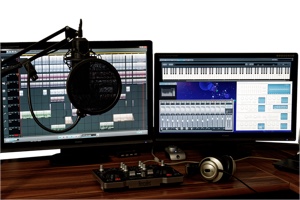
Music Education using Assistive Technology
Annotated bibliography - Web Resources
There is a large market for adaptive technologies to help people with various impairments partake in music. The items w=range from general hardware and software that can be used for specific music purposes to homemade gear that it very specific in its purpose and function. All of it can help students participate in music classes. Here is a partial list of resources.
Websites
A Rough Guide to Assistive Music Technology
The Rough Guide is produced by the Youth Music Network and provides a short overview of assistive technology and a list of tips for integrating assistive technology in music.
Music Technology & Special Needs: Part 1
This site is focused on how to integrate music technology in situation that call for assistive devices. The author details specific steps to integrate technology into music making providing a guide for others. At the end of the article are links to additional resources.
Assistive Technology for Students in Music Class
The author provides a general overview of devices and software that can be used for assisting people with various impairments learn and make music.
Hardware
Enabling Technologies manufactures braille embossers. These embossers are used for braille printouts. These printouts can include braille scores for music (with the right software)
UDL: The hardware that this company produces and sells is essential for people with vision impairments who can read braille. It allows material to be presented physically and tactilely. Students are also able to express themselves through the machine by printing their deliverables.
Humanware sells a wide variety of products designed to help people with vision impairments. The devices are for the full spectrum of vision impairments. They include braille embossers, braille keyboards, and magnifiers.
UDL: The hardware that this company sells is very helpful for people with vision impairments. It allows material to be presented physically and tactilely. Students are also able to express themselves through the machine by creating braille documents and printing their deliverables.
Enabling Technologies manufactures braille embossers and software. The embossers are standard but the software is interesting. Specifically, the IVEO hands-on learning system. This system could be helpful for students learning music but who are not able to read braille music notation.
UDL: The hardware and software from Viewplus helps with student comprehension, perception, physical actions, and expression.
Software
The CERL Sound group are the curators and developers for Lime Music Notation Software. Lime is a helper program that gives educators the ability to produce music notation that can be transcribed into braille. The software is not easily usable by people with vision impairments but does help teachers provide support.
UDL: This software provides support for learners by helping to increase comprehension and possibly communication.
Basics of Lime Screencast
GOODFEEL is the sister software for Lime. GOODFEEL can take the music nation output from Lime and produce a braille score. This score can have verbal and musical queues and also be printed using an embosser.
UDL: GOODFEEL helps learners and educators facilitate greater expression.
BrailleMUSE is a free web application that takes MusicXML files and converts them to .brl braille files. The software is free but may require paid software to produce the source MusicXML files. This software is not user friendly but does have some powerful tools.
UDL: Students who have access to this software will benefit form greater communication and expression.
Developed by educator Toby Rush the braille music notator allows musicians to directly create braille scores without the need for transcribing. It is an online tool that is freely available and provides option to save the output in .brm files. The software also works with screenreaders
UDL: This software allows all individuals to have greater communication and expression by allowing them to create braille scores.
A two-way braille translation software. It is quite expensive but does allow for a variety of translation tasks including music notation. It also includes formatting for braille.
UDL: This software facilitates two way communication between teachers and students by translating from english alphabet to braille and back.
Tocatta is a braille music transcriber. It has all of the standard features and a number of unique features. It allows import from midi file and also is able to transcribe one instrument from a large score.
UDL: Tocatta while part of a crowded field of transcribers still provides the same benefits of communication, expression, and engagement.
Miscellaneous
Provides resources (not free) for people with vision impairments, specifically printed materials. There a re number of music specific materials designed to provide resources for people playing music, reading, music and learning braille music notation.
UDL: This site provides that tools that allow learners to build a vocabulary related to the material which in turn promotes greater communication and engagement.
Provides a list of adaptive gear (provided by cyber-friends) that can be used for music. This gear is a mixture of amateur design and professional production. The gear can be used in classrooms to increase accessibility beyond computers.
UDL: The gear listed on the site is useful for improving physical interactions in class, expression, and maintaining interest.